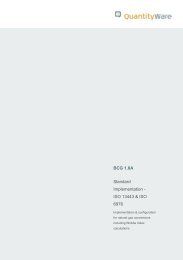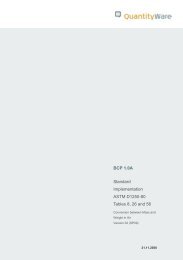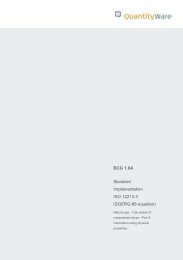QuantityWare - ASTM D1250-04_ASTM_D1250-80 comparison
QuantityWare - ASTM D1250-04_ASTM_D1250-80 comparison
QuantityWare - ASTM D1250-04_ASTM_D1250-80 comparison
- No tags were found...
You also want an ePaper? Increase the reach of your titles
YUMPU automatically turns print PDFs into web optimized ePapers that Google loves.
<strong>QuantityWare</strong>Working PaperComparison of <strong>ASTM</strong><strong>D1250</strong> standardimplementations“Brute force” <strong>comparison</strong>calculations to examine thedifferences between <strong>ASTM</strong> <strong>D1250</strong>-52 / <strong>ASTM</strong> <strong>D1250</strong>-<strong>80</strong> /<strong>ASTM</strong> <strong>D1250</strong>-<strong>04</strong>implementations18.01.2011
Notes© Copyright 2010 <strong>QuantityWare</strong> GmbH. All rights reserved.SAP, R/3, mySAP, mySAP.com, xApps, xApp, SAP NetWeaver, and other SAP products and servicesmentioned herein as well as their respective logos are trademarks or registered trademarks of SAP AG inGermany and in several other countries all over the world. All other product and service names mentionedare the trademarks of their respective companies.Microsoft, Windows, SQL-Server, Powerpoint and Outlook are registered trademarks of MicrosoftCorporation.These materials and the information therein are subject to change without notice. These materials areprovided by the company <strong>QuantityWare</strong> GmbH for informational purposes only. There is no impliedrepresentation or warranty of any kind, and <strong>QuantityWare</strong> GmbH shall not be liable for errors or omissionswith respect to the materials provided. The only warranties for the products and services of <strong>QuantityWare</strong>GmbH are those set forth in the express warranty statements accompanying such products and services, ifany. No statement within this document should be construed as constituting an additional warranty.Comparison of <strong>ASTM</strong> <strong>D1250</strong>-<strong>04</strong> and <strong>ASTM</strong> <strong>D1250</strong>-<strong>80</strong> 2/49
5.8. Result analysis - tables 6 A, B, C and D – 19<strong>80</strong> and 20<strong>04</strong> grid ................. 335.9. Result analysis - tables 24 A, B, C and D – 19<strong>80</strong> and 20<strong>04</strong> grid ............... 355.10. Result analysis - tables 54 A, B and D – 19<strong>80</strong> and 20<strong>04</strong> grid .................. 375.11. Result analysis - tables 60 A, B and D – 19<strong>80</strong> and 20<strong>04</strong> grid .................. 395.12. Additional recommendation for even <strong>ASTM</strong> <strong>D1250</strong>-<strong>80</strong> tables ................. 416. Comparison of <strong>ASTM</strong> <strong>D1250</strong>-52 data with <strong>ASTM</strong> <strong>D1250</strong>-<strong>80</strong>/<strong>04</strong> procedures ............. 427. Summary of <strong>ASTM</strong> <strong>D1250</strong> <strong>comparison</strong> analysis – business view ............................. 438. Conclusion .................................................................................................................. 44The <strong>QuantityWare</strong> Recommendation: ............................................................... 449. References ................................................................................................................. 45Annex A: Detailed results – complete calculation grid ................................................... 46Annex B: Detailed results – 90 % calculation grid .......................................................... 47Annex C: Business impact decision matrix .................................................................... 48Comparison of <strong>ASTM</strong> <strong>D1250</strong>-<strong>04</strong> and <strong>ASTM</strong> <strong>D1250</strong>-<strong>80</strong> 4/49
What is shown on this screen? For those unfamiliar with the SAP application, we can provide a„translation‟:MeasurementObserved valueDensity: observed API gravity(vac.)90,0 API GravityTemperature (observed and test) 55,00 °FVolume1000 barrelCalculated results at 60 °FVolume10<strong>04</strong>,220 barrel (BB6)Volume correction factor 1,0<strong>04</strong>22Base density at 60 °F90,9 API GravityIf all companies involved in energy goods movements used the same highly specialized andwell-developed standard, all parties concerned would calculate the same standardizedquantities, independent of environmental conditions; this is however, not the case.Let us consider a single standard - the <strong>ASTM</strong> <strong>D1250</strong> - companies all over the globe currentlyutilize versions from 1952, 19<strong>80</strong> and 20<strong>04</strong> (with respect to temperature and pressurecorrections) for their logistics transaction calculations. In the following chapter we provide ashort historical overview on the development of <strong>ASTM</strong> <strong>D1250</strong>, which shows how the currentsituation developed.Comparison of <strong>ASTM</strong> <strong>D1250</strong>-<strong>04</strong> and <strong>ASTM</strong> <strong>D1250</strong>-<strong>80</strong> 8/49
2. History of <strong>ASTM</strong> <strong>D1250</strong>This chapter provides a short overview of the <strong>ASTM</strong> <strong>D1250</strong>‟s history [2, 4, 5, 6]. For additionalinformation, refer to the web sites and documents of the American Petroleum Institute (API), theAmerican Society for Testing and Materials – <strong>ASTM</strong> International (<strong>ASTM</strong>) and the Institute ofPetroleum (IP).1.2.1. Year 1916 – The startThe first development of the thermal expansion of liquid hydrocarbons was published by theNational Bureau of Standards (US). Owing to the lack of computer technology at this time,printed tables were published reflecting a matrix of density and temperature - the result being avolume correction factor (VCF). It took generations to replace such printed tables with formulaeand procedures that can be implemented in a computer program.The original tables from 1916 were superseded in 1924, 1936 and 1945 by tables in Britishunits.1.2.2. Year 1952 – A big step forwardThe American Society for Testing and Materials (<strong>ASTM</strong>) and the Institute of Petroleum (IP)published the “Blue Book Tables”. For the first time in history these tables covered US units,British (Imperial) units and metric units.These tables were available for a base temperature of 60 °F and 15 °C and for density in APIGravity, Relative density and density (kg/m 3 ), as printed lists in a standard book.Some of these tables are still used today in various countries (e.g. for LPG and NGLcalculations as well as crude oil export calculations, although superseded).1.2.3. Year 1965 – API adopted the 1952 tablesThe American Petroleum Institute (API) adopted the 1952 tables. A major rewrite was started in1974.1.2.4. Year 19<strong>80</strong> – New temperature correction tablesThe API separated the tables and developed sets for different products:- Crude Oil- Refined Products- Special Applications- Lubricating Oils (1982)Comparison of <strong>ASTM</strong> <strong>D1250</strong>-<strong>04</strong> and <strong>ASTM</strong> <strong>D1250</strong>-<strong>80</strong> 9/49
LPGs and NGLs were not yet supported.For the first time in history, the defined implementation procedures and not the printed tableswere “the standard”. However, for reasons of practicality, the printed tables were published asbooks as well. The printed tables provide VCF with 4 decimals accuracy and need to be enteredwith density values that are corrected for glass hydrometer readings.1.2.5. Year 1998 – Support of LPGs and NGLsThe GPA (Gas Processors Association) Technical Publication 25 (TP-25) of tables 23E and 24Eprovided the so far missing modern LPG and NGL support. In 2007, GPA TP-27 also providedsupport for 15 °C and 20 °C LPG and NGL calculations.1.2.6. Year 20<strong>04</strong> – New needs and possibilities new standard <strong>ASTM</strong> <strong>D1250</strong>-<strong>04</strong>After 19<strong>80</strong>, many additional needs of the petroleum industry were registered by the API. In themeantime, computer technology made incredible progress. The API reacted to industry needsand developed a 20<strong>04</strong> version of the Manual of Petroleum Measurement Standards (MPMS)Chapter 11.1, adjunct to the <strong>ASTM</strong> <strong>D1250</strong> standard, which was released in May 20<strong>04</strong>. Theimplementation procedures defined therein represent the standard, which also specifies thetechnical data format and requirements for floating point calculations. Printed table books are nolonger available.ConclusionIf we now consider that for example, legal requirements for excise duty calculations are basedon different versions of <strong>ASTM</strong> <strong>D1250</strong>, and that change management processes in variouscountries around the globe take considerable effort and time, it becomes evident that as amatter of course, various versions of <strong>ASTM</strong> <strong>D1250</strong> for such calculations are still in place.Additionally, changing complex software and hardware landscapes to a new standard version isan extremely costly endeavor.The next chapter lists all implementation procedure changes that came into effect with <strong>ASTM</strong><strong>D1250</strong>-<strong>04</strong>.Comparison of <strong>ASTM</strong> <strong>D1250</strong>-<strong>04</strong> and <strong>ASTM</strong> <strong>D1250</strong>-<strong>80</strong> 10/49
3. Changes between <strong>ASTM</strong> <strong>D1250</strong>-<strong>80</strong> and <strong>ASTM</strong> <strong>D1250</strong>-<strong>04</strong>3.1. <strong>ASTM</strong> <strong>D1250</strong>-<strong>80</strong> implementation guidelinesAt the time when <strong>ASTM</strong> <strong>D1250</strong>-<strong>80</strong> was released, computer technology was not sufficientlydeveloped to allow the processing of complicated procedures whereby the same results,independent of host, operating system and compiler/language used would be returned.Compromises were necessary which lead to rough rounding and in the worst case, differingresults for different implementations (e.g. using FORTRAN, C, or ABAP as a programminglanguage). Furthermore, the procedures (tables) were based on different calculation conditions,such as a temperature base of:60 °F15 °C20 °C (never included into the <strong>ASTM</strong> <strong>D1250</strong>-<strong>80</strong> standard),and a density ofAPI gravityrelative density ordensity (in kg/m 3 ).The implementation procedure provided a separate set of calculation constants for eachstandard/base temperature.This was unacceptable at a time where international trading and movements of petroleumproducts reached new levels - the development of a new standard was required.The API reacted and the new standard reflects the oil industries current and future needs.3.2. Changes between <strong>ASTM</strong> <strong>D1250</strong>-<strong>04</strong> and <strong>ASTM</strong> <strong>D1250</strong>-<strong>80</strong> implementation guidelinesAfter the release of <strong>ASTM</strong> D 1250-<strong>80</strong> in 19<strong>80</strong> the needs of the oil industry diversified andcomputer technology made considerable progress. It was time to improve the standard. This listof changes is taken from reference [2] and [6].The 19<strong>80</strong> Petroleum Measurement Tables were based upon data obtained using theInternational Practical temperature Scale 1968 (IPTS-68) which has been supersededby the International Temperature Scale 1990 (ITS-90). Input temperatures aremeasured using ITS-90 and must be converted to IPTS-68, before any calculations areComparison of <strong>ASTM</strong> <strong>D1250</strong>-<strong>04</strong> and <strong>ASTM</strong> <strong>D1250</strong>-<strong>80</strong> 11/49
performed, which are based on a model derived from experimental data taken withIPTS-68, standard densities are also adjusted accordingly.The accepted value of the standard density of water at 60 °F has changed slightly fromthe value of 999,012 kg/m 3 - used in the <strong>ASTM</strong> <strong>D1250</strong>-<strong>80</strong> standard implementationprocedures - to 999,016 kg/m 3 . This affects the conversion of density values withrelative density and API gravity. The impact of this change can be seen in Tables 5, 6,23, and 24. The (absolute) density calculations are not affected by this change.In 1988 the IP produced implementation procedures for 20 °C (Tables 59 A, B and Dand 60 A, B and D) by extending the procedures used for the 15 °C Tables. This was inresponse to the needs of countries that use 20 °C as their standard temperature. Thecalculation based on 20 °C is now included in <strong>ASTM</strong> <strong>D1250</strong>-<strong>04</strong>.Tables for lubricating oils were developed and approved as part the <strong>ASTM</strong> <strong>D1250</strong>, butwere never fully documented. The implementation procedures are now incorporated in<strong>ASTM</strong> <strong>D1250</strong>-<strong>04</strong>.Rounding of density values in metric tables changed from 0.5 kg/m³ to 0.1 kg/m³, toimprove discrimination and harmonize with various national standards referring to<strong>ASTM</strong> <strong>D1250</strong>, e.g. DIN 51757.The temperature and density ranges have now been extended to lower temperaturesand higher densities (i.e., lower API gravities) and the gaps still present in <strong>ASTM</strong><strong>D1250</strong>-<strong>80</strong> have been removed.Real-time density measurement using density meters has become more commonlyused for input into VCF calculations; the usage of such devices results in higherpressures at the point of measurement. This pressure effect must be taken into accountsimultaneously with temperature effects. Pressure and temperature corrections havebeen combined into one procedure.The term VCF has been replaced with the term CTPL (Correction for Temperature andPressure of a Liquid), the temperature portion now being called CTL.Comparison of <strong>ASTM</strong> <strong>D1250</strong>-<strong>04</strong> and <strong>ASTM</strong> <strong>D1250</strong>-<strong>80</strong> 12/49
factor in relation to the base temperature (15 °C, 20 °C or 60 °F). In <strong>ASTM</strong> D 1250-<strong>04</strong>all procedures provide the calculation of Special Applications in the same way. Thethermal expansion factor must now always be provided based on 60 °F in units of 1/°For 1/°C.Previous editions of the printed tables assumed that density measurements were madewith a glass hydrometer. The odd-numbered printed 19<strong>80</strong> Tables all included ahydrometer correction on the observed density. In the new <strong>ASTM</strong> <strong>D1250</strong>-<strong>04</strong> standard,no glass hydrometer corrections are applied. Methods to correct glass hydrometerreadings for use in this standard are given in API MPMS Chapter 9 and can be appliedbefore the calculation.Comparison of <strong>ASTM</strong> <strong>D1250</strong>-<strong>04</strong> and <strong>ASTM</strong> <strong>D1250</strong>-<strong>80</strong> 14/49
4. Comparison methodology: <strong>ASTM</strong> <strong>D1250</strong>-<strong>80</strong> and <strong>ASTM</strong> <strong>D1250</strong>-<strong>04</strong>4.1. Comparison methodology overviewBased on the list of differences described in the previous chapter, only a rough assessment canbe made as to the order of magnitude of differences that may be encountered when comparingcalculation results of base densities and volume correction factors.Differences in the order of magnitude of 10 -4 for density values are to be expected, as well asdifferences in the calculated volume correction factors (VCF) in the order of magnitude of 10 -4 to10 -5 . It is however, hard to predict how many calculation points will actually show differences atall, if business relevant rounding is applied to calculation results or input data.For this reason, we decided to utilize a “Brute-Force” method to obtain an overview on themagnitude and distribution of deviations between <strong>ASTM</strong> <strong>D1250</strong>-<strong>80</strong> and <strong>ASTM</strong> <strong>D1250</strong>-<strong>04</strong>calculation results. We calculated, for more than one billion data points (where each point isdefined as one temperature and one density value within a calculation grid), the base densitiesand volume correction factors for each standard implementation and compared the resultingvalues.There are three main complicating facts when attempting to compare <strong>ASTM</strong> <strong>D1250</strong>-<strong>80</strong> with<strong>ASTM</strong> <strong>D1250</strong>-<strong>04</strong> calculation results:The input rounding increments defined for <strong>ASTM</strong> <strong>D1250</strong>-<strong>80</strong> differ from those defined in<strong>ASTM</strong> <strong>D1250</strong>-<strong>04</strong> (no rounding except VCF to five decimals)The density and temperature ranges differ between <strong>ASTM</strong> <strong>D1250</strong>-<strong>80</strong> and <strong>ASTM</strong><strong>D1250</strong>-<strong>04</strong>, <strong>ASTM</strong> <strong>D1250</strong>-<strong>04</strong> provides extended rangesDifferent country specific rounding and accuracy rules have to be consideredOne example for country specific rounding rules is the so called “German rounding”.“German rounding (GR)” is a term that is utilized within the SAP Oil &Gas ERP community todescribe the fact that metric <strong>ASTM</strong> <strong>D1250</strong> table calculations require rounding of observedtemperature values in °C to 0,05 °C, and rounding of observed density values in kg/m³ to 0,1Comparison of <strong>ASTM</strong> <strong>D1250</strong>-<strong>04</strong> and <strong>ASTM</strong> <strong>D1250</strong>-<strong>80</strong> 15/49
kg/m³. This is a requirement of many European and Asian countries where, e.g. the legacy APIc-codes (<strong>ASTM</strong> <strong>D1250</strong>-<strong>80</strong>) have been changed to round density values to 0,1 kg/m³ and thetemperature rounding has been left unchanged at 0,05 °C.Note that German Industry Standard DIN 51757-94 on the other side defines the rounding ofobserved (input) data as follows:If you use the odd tables 53A, B, and D, round the observed temperature values in °Cto 0,05 °C, and round the observed density values in kg/m³ to 0,1 kg/m³If you use the even tables 54A, B, and D, round the observed temperature values in °Cto 0,1 °C, and round the observed density values in kg/m³ to 0,1 kg/m³Within <strong>QuantityWare</strong> BCP implementations, “German rounding” of temperature values isdefined at 0,05 °C; customers requiring the even table rounding according to DIN 51757-94have to ensure via system configuration that temperature values are passed rounded to 0,1 °Caccuracy to the calculation.In addition, DIN 51757-94 requires that volume correction factors are always applied rounded tofour decimal places, while standards in other countries may either adhere to the <strong>ASTM</strong> <strong>D1250</strong>-<strong>80</strong> distinction between five decimal volume correction factors for values less than 1 and fourdecimals for values greater than 1, or follow the approach chosen by DIN 51757-94.Comparison of <strong>ASTM</strong> <strong>D1250</strong>-<strong>04</strong> and <strong>ASTM</strong> <strong>D1250</strong>-<strong>80</strong> 16/49
4.2. Comparison methodology detailsBased on this list of complexities, when attempting to perform <strong>comparison</strong> calculations between<strong>ASTM</strong> <strong>D1250</strong>-<strong>80</strong> and <strong>ASTM</strong> <strong>D1250</strong>-<strong>04</strong>, a meaningful <strong>comparison</strong> grid must be defined withfinite incrementing steps for density and temperature values. In order to define this grid, wecompiled table 1 to support our choice.Input and result rounding <strong>ASTM</strong> <strong>D1250</strong>-<strong>80</strong> / <strong>04</strong>InputOutput19<strong>80</strong> 20<strong>04</strong> 19<strong>80</strong> 20<strong>04</strong>Table Density Temp. Density Temp. Density5A,B,D 0,1 0,1 none none 0,1 none23A,B,D 0,0005 0,1 none none 0,0001 none53A,B,D 0,5 0,05 none none 0,1 none59A,B,D 0,5 0,05 none none 0,1 none53A,B,D (GR) 0,1 0,05 not relevant not relevant 0,1 not relevant59A,B,D (GR) 0,1 0,05 not relevant not relevant 0,1 not relevantVCF6A,B,D 0,1 0,1 none none 0,0001 or 0,00001 0,0000124A,B,D 0,0005 0,1 none none 0,0001 or 0,00001 0,0000154A,B,D 0,5 0,05 none none 0,0001 or 0,00001 0,0000160A,B,D 0,5 0,05 none none 0,0001 or 0,00001 0,0000154A,B,D (GR) 0,1 0,05 not relevant not relevant 0,0001 or 0,00001 0,0000160A,B,D (GR) 0,1 0,05 not relevant not relevant 0,0001 or 0,00001 0,000016C 0,0000005 0,1 none none 0,0001 or 0,00001 0,0000124C 0,0000005 0,1 none none 0,0001 or 0,00001 0,0000154C 0,000001 0,05 none none 0,0001 or 0,00001 0,0000160C 0,000001 0,05 none none 0,0001 or 0,00001 0,00001Table 1: Shown is the rounding increment in respective units of measure (°API for tables 5 & 6, relativedensity for tables 23 & 24, absolute density in kg/m³ for tables 53, 54, 59 & 60, °F for tables 5,6,23 & 24,°C for tables 53, 54, 59 & 60, 1/ °C for tables 54C and 60C, 1/ °F for tables 6C and 24C) which isdefined/applied in the respective implementation guidelines. The “German rounding rule” implementationsare listed as well.Comparison of <strong>ASTM</strong> <strong>D1250</strong>-<strong>04</strong> and <strong>ASTM</strong> <strong>D1250</strong>-<strong>80</strong> 17/49
We then defined the following grid increments for our <strong>comparison</strong> calculations: These gridincrements were taken from the <strong>ASTM</strong> <strong>D1250</strong>-<strong>04</strong> implementation guidelines [2]:<strong>ASTM</strong> <strong>D1250</strong>-<strong>80</strong>/<strong>04</strong> <strong>comparison</strong> gridInputOutputTable Density Temperature Density5A,B,D 0,1 0,1 0,123A,B,D 0,0001 0,1 0,000153A,B,D 0,1 0,05 0,159A,B,D 0,1 0,05 0,1VCF6A,B,D 0,1 0,1 0,0001 0,0000124A,B,D 0,0001 0,1 0,0001 0,0000154A,B,D 0,1 0,05 0,0001 0,0000160A,B,D 0,1 0,05 0,0001 0,000016C 0,000001 0,1 0,0001 0,0000124C 0,000001 0,1 0,0001 0,00001Table 2: Shown is the rounding increment in respective units of measure (°API for tables 5 & 6, relativedensity for tables 23 & 24, absolute density in kg/m³ for tables 53,54,59 & 60 , °F for tables 5,6,23 & 24, °Cfor tables 53,54,59 & 60, 1/ °F for tables 6C and 24C) which we define for our <strong>comparison</strong> calculation grid.Note that the increments marked in red are finer than the original <strong>ASTM</strong> <strong>D1250</strong>-<strong>80</strong> input roundingincrements, thus we expected for these calculations a larger number of differences.We also needed to define the density and temperature ranges for which the <strong>comparison</strong>calculations for the increment grid defined above were run. Here, we chose the <strong>ASTM</strong> <strong>D1250</strong>-<strong>04</strong> ranges as defined in reference [6], but varied the density and temperature values in units of°API and °F (tables 5 and 6), relative density and °F (tables 23 and 24) and kg/m³ (tables 53,54, 59 and 60) with the above defined increments, and compared the results with ourimplementation of <strong>ASTM</strong> <strong>D1250</strong>-<strong>80</strong> with built-in range extensions, as well as with our <strong>ASTM</strong><strong>D1250</strong>-<strong>80</strong> “German rounding” implementation. The limits (adjusted to the accuracy of the gridincrements) are displayed in table 3:Comparison of <strong>ASTM</strong> <strong>D1250</strong>-<strong>04</strong> and <strong>ASTM</strong> <strong>D1250</strong>-<strong>80</strong> 18/49
<strong>ASTM</strong> <strong>D1250</strong>-<strong>04</strong> RangesTemperature °C -50,00 to 150,00Temperature °F -58,0 to 302,0Crude Products LubricantsRel. density @ 60 °F 0,6112 to 1,1646 0,6112 to 1,1646 0,<strong>80</strong>17 to 1,1646°API @ 60 °F 100,0 to -10,0 100,0 to -10,0 45,0 to -10,0Density, kg/m³ @ 15 °C 611,2 to 1163,8 611,2 to 1163,9 <strong>80</strong>1,3 to 1163,9Density, kg/m³ @ 20 °C 606,1 to 1161,2 606,1 to 1160,6 798,1 to 1160,7Thermal exp. coeff., 1/ °F 0,0002300 to 0,0009300Table 3: Shown are the starting and ending density, temperature and thermal expansion coefficient valuesfor our <strong>comparison</strong> calculation grid.With the grid defined in table 2 and 3, we calculated base densities (odd tables) and volumecorrection factors. We then compared:the VCF values of <strong>ASTM</strong> <strong>D1250</strong>-<strong>04</strong> with the respective <strong>ASTM</strong> <strong>D1250</strong>-<strong>80</strong> values and<strong>ASTM</strong> <strong>D1250</strong>-<strong>80</strong> “German rounding” valuesthe VCF values - rounded to four decimals (rounding of exact <strong>ASTM</strong> <strong>D1250</strong>-<strong>04</strong> CTPLvalues) with the respective <strong>ASTM</strong> <strong>D1250</strong>-<strong>80</strong> values and <strong>ASTM</strong> <strong>D1250</strong>-<strong>80</strong> “Germanrounding” valuesthe base density valuesNote that <strong>ASTM</strong> <strong>D1250</strong>-<strong>80</strong> VCF values for temperatures below the base temperature arealways rounded to four decimals, i.e. to a format of 1.XXXX. Thus we expected to see more andlarger VCF differences for temperatures below the base temperature for even numbered tables.We also defined a second smaller grid, where we reduced the temperature intervals to the 90 %“real life” case, as well as doubling the temperature increment steps. In this way, we obtained adistribution estimate of the differences found. The theoretical model used for calculationdefinition suggested that more differences will be found if temperature values move furtheraway from the respective base temperature.Comparison of <strong>ASTM</strong> <strong>D1250</strong>-<strong>04</strong> and <strong>ASTM</strong> <strong>D1250</strong>-<strong>80</strong> 19/49
For this grid we chose a symmetrical temperature interval around the base temperature. Thevalues are listed in table 4.<strong>ASTM</strong> <strong>D1250</strong>-<strong>04</strong> 90 % Temperature ranges & gridTemperature °C ( 15 ° base)Temperature °C ( 20 ° base)Temperature °F-10,00 to 40,00 - 0,1 increment-5,00 to 45,00 - 0,1 increment14,0 to 1<strong>04</strong>,0 - 0,2 incrementTable 4: Shown are the starting and ending temperature of the 90 % “real life” grid, as well as theincrement steps. 90 % “real life” means that within that temperature range, 90 % of crude oil and productmovements (in terms of volume) take place globally on a daily basis. This assumption may of course beviolated if we consider countries that produce exclusively in very cold or very hot climates.4.2.1. Tables 5 and 6 <strong>comparison</strong> runFor these tables, we selected the starting and ending API gravity as well as the temperaturerange in °F according to table 3. API gravity was increased by 0,1 per calculation, thetemperature by 0,1 °F per calculation.Firstly, the <strong>ASTM</strong> <strong>D1250</strong>-<strong>04</strong> implementation was called with these values. In order to do so, theAPI gravity values were converted to kg/m³ values, no additional rounding was performed. The°F values were passed directly to the implementation.The resulting exact base density values were converted back to °API and these final valueswere rounded as defined in table 2. We obtained three VCF values, the value rounded to fivedecimals and the exact value, which we rounded to two VCF with four decimals (one statisticallyrounded, one commercially rounded).The <strong>ASTM</strong> <strong>D1250</strong>-<strong>80</strong> implementation was called with the increment values as defined in table1, followed by the <strong>ASTM</strong> <strong>D1250</strong>-<strong>80</strong> defined input value rounding, (occurring within theimplementation). After input value rounding, API gravity was converted to an absolute densityvalue in kg/m³ and that value was rounded to 0,01 kg/m³ by the implementation.The resulting values were also rounded as defined in table 1 within the <strong>ASTM</strong> <strong>D1250</strong>-<strong>80</strong>implementation. We also noted if the <strong>ASTM</strong> <strong>D1250</strong>-<strong>80</strong> calculation was outside the <strong>ASTM</strong><strong>D1250</strong>-<strong>80</strong> defined ranges; such range extension calculations may fail due to the less robustconvergence scheme and differing number format.Comparison of <strong>ASTM</strong> <strong>D1250</strong>-<strong>04</strong> and <strong>ASTM</strong> <strong>D1250</strong>-<strong>80</strong> 20/49
4.2.2. Tables 23 and 24 <strong>comparison</strong> runFor these tables, we chose the starting and ending relative density as well as the temperaturerange in °F according to table 3. The relative density value was increased by 0,0001 percalculation, the temperature by 0,1 °F per calculation.Firstly, the <strong>ASTM</strong> <strong>D1250</strong>-<strong>04</strong> implementation was called with these values. In order to do so, therelative density values were converted to kg/m³ values and no additional rounding wasperformed. The °F values were passed to directly the implementation.The resulting exact base density values were converted back to relative density values andthese final values were rounded as defined in table 2. We obtained three VCF values, the valuerounded to five decimals and the exact value, which we rounded to two VCF with four decimals(one statistically rounded, one commercially rounded).The <strong>ASTM</strong> <strong>D1250</strong>-<strong>80</strong> implementation was called with the increment values as defined in table1, followed by the <strong>ASTM</strong> <strong>D1250</strong>-<strong>80</strong> defined input value rounding, (occurring within theimplementation). After input value rounding, relative density was converted to an absolutedensity value in kg/m³ and that value was rounded to 0,01 kg/m³ by the implementation.We also noted if the <strong>ASTM</strong> <strong>D1250</strong>-<strong>80</strong> calculation was outside the <strong>ASTM</strong> <strong>D1250</strong>-<strong>80</strong> definedranges; such range extension calculations may fail due to the less robust convergence schemeand differing number format.4.2.3. Tables 53, 54, 59 and 60 <strong>comparison</strong> runFor these tables, we chose the starting and ending absolute density as well as the temperaturerange in °C according to table 3. The absolute density starting value was increased by 0,1 percalculation, the temperature by 0,05 °C per calculation.Firstly, the <strong>ASTM</strong> <strong>D1250</strong>-<strong>04</strong> implementation was called with these values. In order to do so, theabsolute density values in kg/m³ values were passed without additional rounding to thecalculation procedure. The °C values were converted to ° F values and passed to theimplementation directly without further rounding.The resulting exact base density values in kg/m³ were rounded as defined in table 2. Weobtained three VCF values, the value rounded to five decimals and the exact value, which werounded to two VCF with four decimals (one statistically rounded, one commercially rounded).The <strong>ASTM</strong> <strong>D1250</strong>-<strong>80</strong> implementation was called with the increment values without furtherconversion; internal rounding as defined in table 1 was performed within the implementation.Comparison of <strong>ASTM</strong> <strong>D1250</strong>-<strong>04</strong> and <strong>ASTM</strong> <strong>D1250</strong>-<strong>80</strong> 21/49
The resulting values were also rounded as defined in table 1 within the <strong>ASTM</strong> <strong>D1250</strong>-<strong>80</strong>implementation. We also noted if the <strong>ASTM</strong> <strong>D1250</strong>-<strong>80</strong> calculation was outside the <strong>ASTM</strong><strong>D1250</strong>-<strong>80</strong> defined ranges; such range extension calculations may fail due to the less robustconvergence scheme and differing number format.In addition, we called the <strong>ASTM</strong> <strong>D1250</strong>-<strong>80</strong> implementation with built in “German rounding” andcompared these results with the <strong>ASTM</strong> <strong>D1250</strong>-<strong>04</strong> calculations.4.2.4. Special application tables <strong>comparison</strong> runOnly the special application tables 6C and 24C were compared in this paper. This restriction iscaused by the fact that the <strong>ASTM</strong> <strong>D1250</strong>-<strong>80</strong> allows the entry of a thermal expansion factor at 15°C (tables 54C and 60C). This is no longer possible with <strong>ASTM</strong> <strong>D1250</strong>-<strong>04</strong> as a thermalexpansion factor at 60 °F is now required as input for all procedures.We repeated the runs described above using the 90 % “real life” temperaturegrid for all tables to obtain a good estimate on the distribution of differences –increasing relevance for business decision makers.Comparison of <strong>ASTM</strong> <strong>D1250</strong>-<strong>04</strong> and <strong>ASTM</strong> <strong>D1250</strong>-<strong>80</strong> 22/49
5. Comparison results: <strong>ASTM</strong> <strong>D1250</strong>-<strong>80</strong> and <strong>ASTM</strong> <strong>D1250</strong>-<strong>04</strong>The <strong>comparison</strong> calculations as described above were performed in the main developmentsystem at <strong>QuantityWare</strong> GmbH.In total, more than 1,2 billion calculations were performed. From the total amount, exactly1.152.342.059 <strong>comparison</strong> calculations were successful. The remaining calculation <strong>comparison</strong>„failures‟ occurred owing to convergence issues with <strong>ASTM</strong> <strong>D1250</strong>-<strong>80</strong> (described in Chapter 4).The results of each single <strong>comparison</strong> calculation can be assigned to one of five meaningfulcategories:CategoryIDShortdescriptionExplanation1 All calculations All calculation points within the <strong>comparison</strong> grid2<strong>80</strong> range, <strong>04</strong>incrementOnly calculation points within the 19<strong>80</strong> density andtemperature ranges for all <strong>comparison</strong> grid points3<strong>80</strong> range,<strong>80</strong>incrementOnly calculation points within the 19<strong>80</strong> density andtemperature ranges, only calculation points that would lie onthe coarser 19<strong>80</strong> input rounding grid are considered4outside <strong>80</strong> range,<strong>04</strong> incrementOnly calculation points outside the 19<strong>80</strong> density andtemperature ranges for all <strong>comparison</strong> grid points5Outside <strong>80</strong> range,<strong>80</strong> incrementOnly calculation points outside the 19<strong>80</strong> density andtemperature ranges, only calculation points that would lie onthe coarser 19<strong>80</strong> input rounding grid are consideredFor each category, we also list whether a calculation is performed for a temperature below, at orabove the base temperature, thus each run provides summarized data for 15 categories.Additionally, for tables 53, 54, 59 and 60 we provide results for all 15 categories for the<strong>comparison</strong> of “German rounding rule” <strong>ASTM</strong> <strong>D1250</strong>-<strong>80</strong> implementations with <strong>ASTM</strong> <strong>D1250</strong>-<strong>04</strong>.Comparison of <strong>ASTM</strong> <strong>D1250</strong>-<strong>04</strong> and <strong>ASTM</strong> <strong>D1250</strong>-<strong>80</strong> 23/49
For each category, the following <strong>comparison</strong> data was calculated:Number of grid points (maximum calculations)Number of successful calculations (may be smaller than calculated grid points)Number of deviations foundNumber of deviations where 20<strong>04</strong> result lies above 19<strong>80</strong> resultNumber of deviations where 20<strong>04</strong> result lies below 19<strong>80</strong> resultNumber of deviations which differ by one grid result rounding incrementNumber of deviations which differ by more than one grid result rounding incrementMaximum deviation valueTemperature value closest to base at which maximum deviation occursDensity value for closest temperature value where maximum deviation occursThus, for odd numbered <strong>ASTM</strong> <strong>D1250</strong>-<strong>80</strong> tables we obtained <strong>comparison</strong> data for the basedensity values.For even numbered <strong>ASTM</strong> <strong>D1250</strong>-<strong>80</strong> tables we obtained <strong>comparison</strong> data for five decimalvolume correction factor values and four decimal volume correction factor values.One result of our analysis was that no difference was detected between statistical rounding andcommercial rounding of the <strong>ASTM</strong> <strong>D1250</strong>-<strong>04</strong> implementations‟ full accuracy volume correctionfactor.As indicated above, we first compared more than one billion (1.021.268.9<strong>80</strong>) calculations for thecomplete <strong>ASTM</strong> <strong>D1250</strong>-<strong>04</strong> calculation grid. These calculations took around 150 hour netcalculation time in our SAP Oil & Gas ERP system.We then compared more than 100 million (131.073.079) calculations for the reduced 90 % “reallife” calculation grid. These calculations took around 15 hour net calculation time in the samesystem.5.1. Detailed <strong>comparison</strong> results – complete gridThe detailed results of our complete grid calculation <strong>comparison</strong> analysis can be found in theseparate Annex A document to this working paper, just click the following link: Annex A5.2. Detailed <strong>comparison</strong> results – 90 % “real life” gridThe detailed results of our 90 % “real life” grid <strong>comparison</strong> analysis can be found in theseparate Annex B document to this working paper, just click the following link: Annex BComparison of <strong>ASTM</strong> <strong>D1250</strong>-<strong>04</strong> and <strong>ASTM</strong> <strong>D1250</strong>-<strong>80</strong> 24/49
5.3. Result analysis and business implications - overviewIn the following chapters our results are presented as an overview, based on our detailedresults. For each table group, first for the odd, then the even numbered tables. We then discussthe business implications per table based on our business impact decision matrix defined inAnnex C. In this summary analysis, we evaluate the percentage of differences within the <strong>ASTM</strong><strong>D1250</strong>-<strong>80</strong> ranges, found for two grid categories:The 19<strong>80</strong> grid category where input measurement data is rounded according to <strong>ASTM</strong><strong>D1250</strong>-<strong>80</strong>.The 20<strong>04</strong> grid category, where input measurement data is rounded according to <strong>ASTM</strong><strong>D1250</strong>-<strong>04</strong>. Note that the percentage values are rounded to 0,1%.For odd tables, we present the differences‟ results in base densities, which we observed withour <strong>comparison</strong> calculations.For even tables, we present the differences‟ results in volume correction factors (rounded to fiveand four decimals), which we observed with our <strong>comparison</strong> calculations.Based on the known input data rounding differences between <strong>ASTM</strong> <strong>D1250</strong>-<strong>80</strong> and<strong>ASTM</strong> <strong>D1250</strong>-<strong>04</strong> implementations for certain tables, we expect a large % value ofdifferences for these tables, typically <strong>80</strong> %.Since <strong>ASTM</strong> <strong>D1250</strong>-<strong>80</strong> provides a volume correction factor for temperature valuesbelow the base temperature (of the format 1.XXXX (four decimals only), we expect foreven tables, when considering temperature values below the base temperature, a large% value of differences, typically 90 %, since we assume to the fifth digit is evenlydistributed (either 0, 1, 2, 3, 4,…9) throughout the calculation results for such largenumbers of calculations.Thus, differences caused by other changes described in chapter 3 will be “hidden” by thesedominating effects.Finally, the % difference value can be interpreted as a probability to encounter a relevantdifference between your legacy <strong>ASTM</strong> <strong>D1250</strong>-<strong>80</strong> implementation and your new <strong>ASTM</strong> <strong>D1250</strong>-<strong>04</strong> implementation.Comparison of <strong>ASTM</strong> <strong>D1250</strong>-<strong>04</strong> and <strong>ASTM</strong> <strong>D1250</strong>-<strong>80</strong> 25/49
Note that the detailed data given in Annex A and B provides much moreinformation which can be analyzed from a more technical point of view. In thisanalysis, we restrict our interpretation to derive “business relevant guidancestatements” per table.5.4. Result analysis - tables 5 A, B and D – 19<strong>80</strong> and 20<strong>04</strong> gridThe following table summarizes our findings for tables 5 A, B and D. The table contains the %numbers of calculations which showed a difference with respect to the total number ofsuccessful calculations performed in the respective grid. We also print the maximum differencesin °API that we detected. More details can be found in chapter 5.1 and chapter 5.2.<strong>ASTM</strong> <strong>D1250</strong>-<strong>80</strong> Table 5 :% differences found - 20<strong>04</strong> grid, within 19<strong>80</strong> rangesQuantity compared: Base API gravity @ 60 °FA - crude oil B - products D - lubricantsall temperaturesMaximum difference (complete/90%) [°API] 0,1 / 0,1 0,1 / 0,1 0,1 / 0,1complete grid 1,4% 1,5% 3,0%90 % grid 0,7% 0,9% 2,3%temperatures below baseMaximum difference (complete/90%) [°API] 0,1 / 0,1 0,1 / 0,1 0,1 / 0,1complete grid 0,8% 1,0% 2,3%90 % grid 0,7% 0,9% 2,3%temperatures equal or above baseMaximum difference (complete/90%) [°API] 0,1 / 0,1 0,1 / 0,1 0,1 / 0,1complete grid 1,5% 1,7% 3,2%90 % grid 0,7% 0,9% 2,3%The 19<strong>80</strong> and 20<strong>04</strong> results are identical, since both grids are identical. Within the complete19<strong>80</strong> range, an average of 14 (crude), 15 (products) to 30 (lubricants) calculations out of 1.000calculations show a difference of 0.1 °API; Within the 90 % grid, these values drop down furtheras expected.If such a difference of 0.1 °API occurs, the deviations observed in calculated quantities (weightsand masses) can be rather large (0,03%) depending on API gravity absolute value) and may bequestioned by business users and inspectors. However, due to the low average % deviationvalue, the overall average risk is smaller.Comparison of <strong>ASTM</strong> <strong>D1250</strong>-<strong>04</strong> and <strong>ASTM</strong> <strong>D1250</strong>-<strong>80</strong> 26/49
Based on our business impact decision matrix (see Annex C), thefinancial impact of a change from <strong>ASTM</strong> <strong>D1250</strong>-<strong>80</strong> to the <strong>ASTM</strong> <strong>D1250</strong>-<strong>04</strong>version is medium to low for <strong>ASTM</strong> <strong>D1250</strong>-<strong>80</strong> tables 5. Business usersshould be informed that differences can occur with the probabilities givenin the table above, to avoid business process disruptions.5.5. Result analysis - tables 23 A, B and D – 19<strong>80</strong> and 20<strong>04</strong> gridThe following table summarizes our findings for tables 23 A, B and D. The table contains the %numbers of calculations which showed a difference with respect to the total number ofsuccessful calculations performed in the respective grid. We also print the maximum differencesin relative density units (dimension one) that we detected. More details can be found in chapter5.1 and chapter 5.2. The results for the 20<strong>04</strong> grid show the expected <strong>80</strong> % deviations, since theinput relative density for tables 23 (as well as for tables 24) is rounded to 0,0005 in <strong>ASTM</strong><strong>D1250</strong>-<strong>80</strong>, whereas <strong>ASTM</strong> <strong>D1250</strong>-<strong>04</strong> defines no rounding and the grid increment of 0,0001defines the accuracy as:<strong>ASTM</strong> <strong>D1250</strong>-<strong>80</strong> Table 23 :% differences found - 20<strong>04</strong> grid, within 19<strong>80</strong> rangesQuantity compared: Base relative density @ 60 °FA - crude oil B - products D - lubricantsall temperaturesMaximum difference (complete/90%) [1] 0,0003 / 0,0003 0,0003 / 0,0003 0,0003 / 0,0003complete grid 79,5% 79,7% <strong>80</strong>,0%90 % grid <strong>80</strong>,0% 79,9% <strong>80</strong>,0%temperatures below baseMaximum difference (complete/90%) [1] 0,0003 / 0,0003 0,0003 / 0,0003 0,0003 / 0,0003complete grid <strong>80</strong>,3% <strong>80</strong>,2% <strong>80</strong>,0%90 % grid <strong>80</strong>,2% <strong>80</strong>,1% <strong>80</strong>,0%temperatures equal or above baseMaximum difference (complete/90%) [1] 0,0003 / 0,0003 0,0003 / 0,0003 0,0003 / 0,0003complete grid 79,3% 79,6% <strong>80</strong>,0%90 % grid 79,7% 79,8% <strong>80</strong>,0%The results for the 19<strong>80</strong> grid are given in the following table:Comparison of <strong>ASTM</strong> <strong>D1250</strong>-<strong>04</strong> and <strong>ASTM</strong> <strong>D1250</strong>-<strong>80</strong> 27/49
<strong>ASTM</strong> <strong>D1250</strong>-<strong>80</strong> Table 23 :% differences found - 19<strong>80</strong> grid, within 19<strong>80</strong> rangesQuantity compared: Base relative density @ 60 °FA - crude oil B - products D - lubricantsall temperaturesMaximum difference (complete/90%) [1] 0,0001 / 0,0001 0,0001 / 0,0001 0,0001 / 0,0001complete grid 6,8% 6,9% 9,0%90 % grid 3,3% 3,3% 2,9%temperatures below baseMaximum difference (complete/90%) [1] 0,0001 / 0,0001 0,0001 / 0,0001 0,0001 / 0,0001complete grid 3,9% 3,8% 3,4%90 % grid 3,4% 3,4% 3,1%temperatures equal or above baseMaximum difference (complete/90%) [1] 0,0001 / 0,0001 0,0001 / 0,0001 0,0001 / 0,0001complete grid 8,0% 8,2% 10,6%90 % grid 3,3% 3,2% 2,7%If your measurements for relative density are reported with an accuracy of 0,0001, you willobserve differences in base density values in <strong>80</strong> % of the calculations, with a maximumdifference of 0,0003, which converts to a relative difference of approx. 0,03 % (depending onthe absolute density value).If your measurements for relative density are reported with an accuracy of 0,0005, you willobserve, within the complete 19<strong>80</strong> range, an average of 68 (crude), 69 (products) to 90(lubricants) calculations out of 1.000 calculations that show a difference of 0,0001 relativedensity; Within the 90 % grid, these values drop down further as expected.Based on our business impact decision matrix (see Annex C), thefinancial impact of a change from <strong>ASTM</strong> <strong>D1250</strong>-<strong>80</strong> to the <strong>ASTM</strong> <strong>D1250</strong>-<strong>04</strong>version is medium to low for <strong>ASTM</strong> <strong>D1250</strong>-<strong>80</strong> tables 23, if yourmeasurement data, the relative density, is reported with an accuracy of0,0005. Business users should be informed that differences can occurwith the probabilities given in the table above, to avoid business processdisruptions.Based on our business impact decision matrix (see Annex C), thefinancial impact of a change from <strong>ASTM</strong> <strong>D1250</strong>-<strong>80</strong> to the <strong>ASTM</strong> <strong>D1250</strong>-<strong>04</strong>version is high to medium for <strong>ASTM</strong> <strong>D1250</strong>-<strong>80</strong> tables 23, if you alreadywork with measured/observed relative densities with an accuracy of0,0001. A detailed “Safe Passage” project is recommended.Comparison of <strong>ASTM</strong> <strong>D1250</strong>-<strong>04</strong> and <strong>ASTM</strong> <strong>D1250</strong>-<strong>80</strong> 28/49
5.6. Result analysis - tables 53 A, B and D – 19<strong>80</strong> and 20<strong>04</strong> gridThe following table summarizes our findings for tables 53 A, B and D. The table contains the %numbers of calculations which showed a difference with respect to the total number ofsuccessful calculations performed in the respective grid. We also print the maximum differencesin absolute units (kg/m³) that we detected. More details can be found in chapter 5.1 and chapter5.2. The results for the 20<strong>04</strong> grid show the expected <strong>80</strong> % deviations, since the input densityvalues for tables 53 and 54 are rounded to 0,5 kg/m³ in <strong>ASTM</strong> <strong>D1250</strong>-<strong>80</strong>, whereas <strong>ASTM</strong><strong>D1250</strong>-<strong>04</strong> defines no rounding and the grid increment of 0,1 kg/m³ defines the accuracy as:<strong>ASTM</strong> <strong>D1250</strong>-<strong>80</strong> Table 53 :% differences found - 20<strong>04</strong> grid, within 19<strong>80</strong> rangesQuantity compared: Base density @ 15 °CA - crude oil B - products D - lubricantsall temperaturesMaximum difference (complete/90%) [kg/m³] 0,3 / 0,3 0,5 / 0,4 0,3 / 0,3complete grid 79,5% 79,8% <strong>80</strong>,0%90 % grid <strong>80</strong>,0% <strong>80</strong>,0% <strong>80</strong>,0%temperatures below baseMaximum difference (complete/90%) [kg/m³] 0,3 / 0,3 0,5 / 0,4 0,3 / 0,3complete grid <strong>80</strong>,2% <strong>80</strong>,2% <strong>80</strong>,0%90 % grid <strong>80</strong>,2% <strong>80</strong>,2% <strong>80</strong>,0%temperatures equal or above baseMaximum difference (complete/90%) [kg/m³] 0,3 / 0,3 0,3 / 0,3 0,3 / 0,3complete grid 79,3% 79,6% <strong>80</strong>,0%90 % grid 79,8% 79,8% <strong>80</strong>,0%The results for the 19<strong>80</strong> grid are given in the table below; note that we basically obtainedidentical results for the “German rounding” implementation for both the 19<strong>80</strong> and 20<strong>04</strong> grid.<strong>ASTM</strong> <strong>D1250</strong>-<strong>80</strong> Table 53 :% differences found - 19<strong>80</strong> grid, within 19<strong>80</strong> rangesQuantity compared: Base density @ 15 °CA - crude oil B - products D - lubricantsall temperaturesMaximum difference (complete/90%) [kg/m³] 0,1 / 0,1 0,2 / 0,2 0,1 / 0,1complete grid 12,6% 7,9% 3,3%90 % grid 3,7% 3,5% 0,5%temperatures below baseMaximum difference (complete/90%) [kg/m³] 0,1 / 0,1 0,2 / 0,2 0,1 / 0,1complete grid 4,6% 4,0% 0,5%90 % grid 3,6% 3,3% 0,4%temperatures equal or above baseMaximum difference (complete/90%) [kg/m³] 0,1 / 0,1 0,2 / 0,1 0,1 / 0,1complete grid 15,2% 9,3% 4,2%90 % grid 3,8% 3,8% 0,6%Comparison of <strong>ASTM</strong> <strong>D1250</strong>-<strong>04</strong> and <strong>ASTM</strong> <strong>D1250</strong>-<strong>80</strong> 29/49
If your measurements for absolute density are reported with an accuracy of 0,1 kg/m³, you willobserve differences in base density values in <strong>80</strong> % of the calculations, with a maximumdifference of 0,3 to 0,5 kg/m³, which converts to a relative difference of approx. 0,03 %(depending on the absolute density value).If your measurements for absolute density are reported with an accuracy of 0,5 kg/m³ OR if youare already running a modified “German rounding” <strong>ASTM</strong> <strong>D1250</strong>-<strong>80</strong> implementation, you willobserve, within the complete 19<strong>80</strong> range, an average of 126 (crude), 79 (products) to 33(lubricants) calculations out of 1.000 calculations that show a difference of 0,1 kg/m³; Within the90 % grid, these values drop further as expected.Based on our business impact decision matrix (see Annex C), thefinancial impact of a change from <strong>ASTM</strong> <strong>D1250</strong>-<strong>80</strong> to the <strong>ASTM</strong> <strong>D1250</strong>-<strong>04</strong>version is medium to low for <strong>ASTM</strong> <strong>D1250</strong>-<strong>80</strong> tables 53, if yourmeasurement data, the observed density, is reported with an accuracy of0,5 kg/m³ or you are already running an <strong>ASTM</strong> <strong>D1250</strong>-<strong>80</strong> implementationwith “German rounding”. Business users should be informed thatdifferences can occur with the probabilities given in the table above, toavoid business process disruptions.Based on our business impact decision matrix (see Annex C), thefinancial impact of a change from a non-modified <strong>ASTM</strong> <strong>D1250</strong>-<strong>80</strong> to the<strong>ASTM</strong> <strong>D1250</strong>-<strong>04</strong> version is high to medium for <strong>ASTM</strong> <strong>D1250</strong>-<strong>80</strong> tables 53, ifyou already work with measured observed densities with an accuracy of0,1 kg/m³. A detailed “Safe Passage” project is recommended.Comparison of <strong>ASTM</strong> <strong>D1250</strong>-<strong>04</strong> and <strong>ASTM</strong> <strong>D1250</strong>-<strong>80</strong> 30/49
5.7. Result analysis - tables 59 A, B and D – 19<strong>80</strong> and 20<strong>04</strong> gridThe following table summarizes our findings for tables 59 A, B and D. The table contains the %numbers of calculations which showed a difference with respect to the total number ofsuccessful calculations performed in the respective grid. We also print the maximum differencesin absolute units (kg/m³) that we detected. More details can be found in chapter 5.1 and chapter5.2. The results for the 20<strong>04</strong> grid show the expected <strong>80</strong> % deviations, since the input densityvalues for tables 59 and 60 are rounded to 0,5 kg/m³ in <strong>ASTM</strong> <strong>D1250</strong>-<strong>80</strong>, whereas <strong>ASTM</strong><strong>D1250</strong>-<strong>04</strong> defines no rounding and the grid increment of 0,1 kg/m³ defines the accuracy as:% differences found - 20<strong>04</strong> grid, within 19<strong>80</strong> rangesQuantity compared: Base density @ 20 °CA - crude oil B - products D - lubricantsall temperaturesMaximum difference (complete/90%) [kg/m³] 0,3 / 0,3 0,5 / 0,4 0,3 / 0,3complete grid 79,6% 79,8% <strong>80</strong>,0%90 % grid <strong>80</strong>,0% <strong>80</strong>,0% <strong>80</strong>.0%temperatures below baseMaximum difference (complete/90%) [kg/m³] 0,3 / 0,3 0,5 / 0,4 0,3 / 0,3complete grid <strong>80</strong>,3% <strong>80</strong>,3% <strong>80</strong>,0%90 % grid <strong>80</strong>,2% <strong>80</strong>,2% <strong>80</strong>,0%temperatures equal or above baseMaximum difference (complete/90%) [kg/m³] 0,3 / 0,3 0,3 / 0,3 0,3 / 0,3complete grid 79,3% 79,6% <strong>80</strong>,0%90 % grid 79,8% 79,8% <strong>80</strong>,0%The results for the 19<strong>80</strong> grid are given in the table below; note that we basically obtained theidentical results for the “German rounding” implementation for both the 19<strong>80</strong> and 20<strong>04</strong> grid.<strong>ASTM</strong> <strong>D1250</strong>-<strong>80</strong> Table 59 :% differences found - 19<strong>80</strong> grid, within 19<strong>80</strong> rangesQuantity compared: Base density @ 20 °CA - crude oil B - products D - lubricantsall temperaturesMaximum difference (complete/90%) [kg/m³] 0,1 / 0,1 0,2 / 0,2 0,1 / 0,1complete grid 12,1% 7,9% 3,4%90 % grid 3,6% 3,7% 0,4%temperatures below baseMaximum difference (complete/90%) [kg/m³] 0,1 / 0,1 0,2 / 0,2 0,1 / 0,1complete grid 5,6% 5,0% 0,7%90 % grid 3,7% 3,7% 0,2%temperatures equal or above baseMaximum difference (complete/90%) [kg/m³] 0,1 / 0,1 0,2 / 0,1 0,1 / 0,1complete grid 14,6% 9,2% 4,3%90 % grid 3,6% 3,7% 0,6%Comparison of <strong>ASTM</strong> <strong>D1250</strong>-<strong>04</strong> and <strong>ASTM</strong> <strong>D1250</strong>-<strong>80</strong> 31/49
If your measurements for absolute density are reported with an accuracy of 0,1 kg/m³, you willobserve differences in base density values in <strong>80</strong> % of the calculations, with a maximumdifference of 0,3/0,5 kg/m³, which converts to a relative difference of approx. 0,03 % (dependingon the absolute density value).If your measurements for absolute density are reported with an accuracy of 0,5 kg/m³ OR if youare already running a modified “German rounding” <strong>ASTM</strong> <strong>D1250</strong>-<strong>80</strong> implementation, you willobserve, within the complete 19<strong>80</strong> range, an average of 121 (crude), 79 (products) to 34(lubricants) calculations out of 1.000 calculations, that show a maximum difference of 0,2 kg/m³;Within the 90 % grid, these values drop further as expected.Based on our business impact decision matrix (see Annex C), thefinancial impact of a change from <strong>ASTM</strong> <strong>D1250</strong>-<strong>80</strong> to the <strong>ASTM</strong> <strong>D1250</strong>-<strong>04</strong>version is medium to low for <strong>ASTM</strong> <strong>D1250</strong>-<strong>80</strong> tables 59, if yourmeasurement data, the observed density, is reported with an accuracy of0,5 kg/m³ or you are already running an <strong>ASTM</strong> <strong>D1250</strong>-<strong>80</strong> implementationwith “German rounding”. Business users should be informed thatdifferences can occur with the probabilities given in the table above, toavoid business process disruptions.Based on our business impact decision matrix (see Annex C), thefinancial impact of a change from a non-modified <strong>ASTM</strong> <strong>D1250</strong>-<strong>80</strong> to the<strong>ASTM</strong> <strong>D1250</strong>-<strong>04</strong> version is high to medium for <strong>ASTM</strong> <strong>D1250</strong>-<strong>80</strong> tables 59, ifyou already work with measured observed densities with an accuracy of0,1 kg/m³. A detailed “Safe Passage” project is recommended.Comparison of <strong>ASTM</strong> <strong>D1250</strong>-<strong>04</strong> and <strong>ASTM</strong> <strong>D1250</strong>-<strong>80</strong> 32/49
5.8. Result analysis - tables 6 A, B, C and D – 19<strong>80</strong> and 20<strong>04</strong> grid<strong>ASTM</strong> <strong>D1250</strong>-<strong>80</strong> Table 6 :% differences found - 20<strong>04</strong> grid, within 19<strong>80</strong> rangesQuantity compared:Volume correction factor : observed to base, 5 decimalsA - crude oil B - products C - special applications D - lubricantsall temperaturesMaximum difference 0,00006 / 0,00006 0,00006 / 0,00006 0,00007 / 0,00007 0,00006 / 0,00006(complete/90%)grid 75,0% 77,3% 72,4% 78,5%90 % grid 57,9% 61,3% 64,0% 56,4%temperatures below baseMaximum difference 0,00006 / 0,00006 0,00006 / 0,00006 0,00007 / 0,00007 0,00006 / 0,00006(complete/90%)grid 90,0% 90,0% 90,0% 90,0%90 % grid 89,9% 90,0% 90,0% 90,0%temperatures equal or above baseMaximum difference 0,000<strong>04</strong> / 0,00001 0,000<strong>04</strong> / 0,00002 0,00003 / 0,00003 0,000<strong>04</strong> / 0,00001(complete/90%)grid 69,8% 72,0% 64,1% 75,6%90 % grid 24,3% 31,2% 36,9% 21,2%<strong>ASTM</strong> <strong>D1250</strong>-<strong>80</strong> Table 6 :% differences found - 20<strong>04</strong> grid, within 19<strong>80</strong> rangesQuantity compared:Volume correction factor : observed to base, 4 decimalsA - crude oil B - products C - special applications D - lubricantsall temperaturesMaximum difference0,0001 / 0,0001 0,0001 / 0,0001 0,0001 / 0,0001 0,0001 / 0,0001(complete/90%)grid 6,6% 7,0% 9,0% 8,6%90 % grid 1,3% 1,8% 3,1% 1,1%temperatures below baseMaximum difference0,0001 / 0,0001 0,0001 / 0,0001 0,0001 / 0,0001 0,0001 / 0,0001(complete/90%)grid 3,0% 3,8% 5,1% 2,6%90 % grid 2,3% 3,0% 4,0% 2,1%temperatures equal or above baseMaximum difference0,0001 / 0,0001 0,0001 / 0,0001 0,0001 / 0,0001 0,0001 / 0,0001(complete/90%)grid 7,9% 8,3% 10,8% 10,1%90 % grid 0,2% 0,6% 2,2% 0,0%The two tables above summarize our findings for the <strong>ASTM</strong> <strong>D1250</strong>-<strong>80</strong> tables 6. Although <strong>ASTM</strong><strong>D1250</strong>-<strong>04</strong> does not contain the recommendation to round the final volume correction factor tofour decimals, we also compared these values with the <strong>ASTM</strong> <strong>D1250</strong>-<strong>80</strong> four decimal volumecorrection factors (VCF).As expected, since <strong>ASTM</strong> <strong>D1250</strong>-<strong>80</strong> VCF - for temperatures below the base temperature – areavailable with four decimals only, we observe 90 % differences in that range. Above the basetemperature, within the complete 19<strong>80</strong> range, we observe an average of 698 (crude), 720(products), 641 (special applications) to 756 (lubricants) calculations out of 1.000 calculations,that show a maximum difference of 0,000<strong>04</strong>; Within the 90 % grid, these values dropconsiderably as expected.The four decimal results list the differences one has to expect when considering calculating withan <strong>ASTM</strong> <strong>D1250</strong>-<strong>04</strong> implementation where the VCF is still rounded to four decimals.Comparison of <strong>ASTM</strong> <strong>D1250</strong>-<strong>04</strong> and <strong>ASTM</strong> <strong>D1250</strong>-<strong>80</strong> 33/49
<strong>ASTM</strong> <strong>D1250</strong>-<strong>80</strong> Table 6 :% differences found - 19<strong>80</strong> grid, within 19<strong>80</strong> rangesQuantity compared:Volume correction factor : observed to base, 5 decimalsA - crude oil B - products C - special applications D - lubricantsall temperaturesMaximum difference 0,00006 / 0,00006 0,00006 / 0,00006 0,00006 / 0,00006 0,00006 / 0,00006(complete/90%)grid 75,0% 77,3% 78,4% 78,5%90 % grid 57,9% 61,3% 63,4% 56,4%temperatures below baseMaximum difference 0,00006 / 0,00006 0,00006 / 0,00006 0,00006 / 0,00006 0,00006 / 0,00006(complete/90%)grid 90,0% 90,0% 90,0% 90,0%90 % grid 89,9% 90,0% 90,0% 90,0%temperatures equal or above baseMaximum difference 0,000<strong>04</strong> / 0,00001 0,000<strong>04</strong> / 0,00002 0,00003 / 0,00002 0,000<strong>04</strong> / 0,00001(complete/90%)grid 69,8% 72,0% 73,0% 75,6%90 % grid 24,3% 31,2% 35,5% 21,2%<strong>ASTM</strong> <strong>D1250</strong>-<strong>80</strong> Table 6 :% differences found - 19<strong>80</strong> grid, within 19<strong>80</strong> rangesQuantity compared:Volume correction factor : observed to base, 4 decimalsA - crude oil B - products C - special applications D - lubricantsall temperaturesMaximum difference0,0001 / 0,0001 0,0001 / 0,0001 0,0001 / 0,0001 0,0001 / 0,0001(complete/90%)grid 6,6% 7,0% 7,1% 8,6%90 % grid 1,3% 1,8% 2,3% 1,1%temperatures below baseMaximum difference0,0001 / 0,0001 0,0001 / 0,0001 0,0001 / 0,0001 0,0001 / 0,0001(complete/90%)grid 3,0% 3,8% 4,4% 2,6%90 % grid 2,3% 3,0% 3,4% 2,1%temperatures equal or above baseMaximum difference0,0001 / 0,0001 0,0001 / 0,0001 0,0001 / 0,0001 0,0001 / 0,0001(complete/90%)grid 7,9% 8,3% 8,3% 10,1%90 % grid 0,2% 0,6% 1,0% 0,0%As expected, with the exception of table 6C, the results for the 19<strong>80</strong> range grid are identical tothe 20<strong>04</strong> range grid (shown previously).Based on our business impact decision matrix (see Annex C), thefinancial impact of a change from <strong>ASTM</strong> <strong>D1250</strong>-<strong>80</strong> to the <strong>ASTM</strong> <strong>D1250</strong>-<strong>04</strong>version is medium to low for <strong>ASTM</strong> <strong>D1250</strong>-<strong>80</strong> tables 6. Business usersshould be informed that differences can occur with the probabilities givenin the table above, to avoid business process disruptionsComparison of <strong>ASTM</strong> <strong>D1250</strong>-<strong>04</strong> and <strong>ASTM</strong> <strong>D1250</strong>-<strong>80</strong> 34/49
5.9. Result analysis - tables 24 A, B, C and D – 19<strong>80</strong> and 20<strong>04</strong> grid<strong>ASTM</strong> <strong>D1250</strong>-<strong>80</strong> Table 24 :% differences found - 20<strong>04</strong> grid, within 19<strong>80</strong> rangesQuantity compared:Volume correction factor : observed to base, 5 decimalsA - crude oil B - products C - special applications D - lubricantsall temperaturesMaximum difference 0,00008 / 0,00007 0,00021 / 0,00011 0,00007 / 0,00007 0,00007 / 0,00006(complete/90%)grid 71,4% 70,8% 72,4% 71,0%90 % grid 60,6% 62,1% 64,0% 56,2%temperatures below baseMaximum difference 0,00008 / 0,00007 0,00013 / 0,00011 0,00007 / 0,00007 0,00006 / 0,00006(complete/90%)grid 90,0% 90,1% 90,0% 90,0%90 % grid 90,0% 90,0% 90,0% 90,1%temperatures equal or above baseMaximum difference 0,00008 / 0,00003 0,00021 / 0,00007 0,00007 / 0,00003 0,00007 / 0,00002(complete/90%)grid 65,1% 63,4% 64,1% 66,3%90 % grid 29,9% 32,9% 36,9% 20,9%<strong>ASTM</strong> <strong>D1250</strong>-<strong>80</strong> Table 24 :% differences found - 20<strong>04</strong> grid, within 19<strong>80</strong> rangesQuantity compared:Volume correction factor : observed to base, 4 decimalsA - crude oil B - products C - special applications D - lubricantsall temperaturesMaximum difference0,0001 / 0,0001 0,0003 / 0,0001 0,0001 / 0,0001 0,0001 / 0,0001(complete/90%)grid 9,3% 9,2% 9,0% 8,6%90 % grid 2,3% 3,1% 3,1% 1,2%temperatures below baseMaximum difference0,0001 / 0,0001 0,0001 / 0,0001 0,0001 / 0,0001 0,0001 / 0,0001(complete/90%)grid 4,1% 5,2% 5,1% 2,6%90 % grid 3,2% 4,0% 4,0% 2,0%temperatures equal or above baseMaximum difference0,0001 / 0,0001 0,0003 / 0,0001 0,0001 / 0,0001 0,0001 / 0,0001(complete/90%)grid 11,1% 10,7% 10,8% 10,1%90 % grid 1,3% 2,2% 2,2% 0,3%The two tables above summarize our findings for the <strong>ASTM</strong> <strong>D1250</strong>-<strong>80</strong> tables 24. Although<strong>ASTM</strong> <strong>D1250</strong>-<strong>04</strong> does not contain the recommendation to round the final volume correctionfactor to four decimals, we also compared these values with the <strong>ASTM</strong> <strong>D1250</strong>-<strong>80</strong> four decimalvolume correction factors (VCF).As expected, since <strong>ASTM</strong> <strong>D1250</strong>-<strong>80</strong> VCFs - for temperatures below the base temperature – arecalculated with four decimals only, we observe 90 % differences in that range. Above the basetemperature, within the complete 19<strong>80</strong> range, we observe an average of 651 (crude), 634(products), 641 (special applications) to 663 (lubricants) calculations out of 1.000 calculationsthat show a maximum difference of 0,00021; Within the 90 % grid, these values dropconsiderably as expected.The four decimal results list the differences one has to expect when considering running an<strong>ASTM</strong> <strong>D1250</strong>-<strong>04</strong> implementation where the VCF is still rounded to four decimals.Comparison of <strong>ASTM</strong> <strong>D1250</strong>-<strong>04</strong> and <strong>ASTM</strong> <strong>D1250</strong>-<strong>80</strong> 35/49
<strong>ASTM</strong> <strong>D1250</strong>-<strong>80</strong> Table 24 :% differences found - 19<strong>80</strong> grid, within 19<strong>80</strong> rangesQuantity compared:Volume correction factor : observed to base, 5 decimalsA - crude oil B - products C - special applications D - lubricantsall temperaturesMaximum difference 0,00006 / 0,00006 0,00006 / 0,00006 0,00006 / 0,00006 0,00006 / 0,00006(complete/90%)grid 75,0% 76,7% 78,4% 77,8%90 % grid 57,4% 59,8% 63,4% 56,0%temperatures below baseMaximum difference 0,00006 / 0,00006 0,00006 / 0,00006 0,00006 / 0,00006 0,00006 / 0,00006(complete/90%)grid 90,0% 90,0% 90,0% 90,0%90 % grid 90,0% 90,0% 90,0% 90,1%temperatures equal or above baseMaximum difference 0,000<strong>04</strong> / 0,00001 0,000<strong>04</strong> / 0,00002 0,00003 / 0,00002 0,000<strong>04</strong> / 0,00001(complete/90%)grid 69,9% 71,4% 73,0% 74,7%90 % grid 23,3% 28,3% 35,5% 20,5%<strong>ASTM</strong> <strong>D1250</strong>-<strong>80</strong> Table 24 :% differences found - 19<strong>80</strong> grid, within 19<strong>80</strong> rangesQuantity compared:Volume correction factor : observed to base, 4 decimalsA - crude oil B - products C - special applications D - lubricantsall temperaturesMaximum difference0,0001 / 0,0001 0,0001 / 0,0001 0,0001 / 0,0001 0,0001 / 0,0001(complete/90%)grid 6,6% 6,9% 7,1% 8,4%90 % grid 1,2% 1,6% 2,3% 1,0%temperatures below baseMaximum difference0,0001 / 0,0001 0,0001 / 0,0001 0,0001 / 0,0001 0,0001 / 0,0001(complete/90%)grid 3,9% 3,5% 4,4% 2,5%90 % grid 2,3% 2,7% 3,4% 1,9%temperatures equal or above baseMaximum difference0,0001 / 0,0001 0,0001 / 0,0001 0,0001 / 0,0001 0,0001 / 0,0001(complete/90%)grid 7,0% 8,2% 8,3% 9,8%90 % grid 0,2% 0,5% 1,0% 0,0%The results for the complete 19<strong>80</strong> grid show a slightly higher % value of differences, whichreverses within the 90% “real life” grid. This is apparently a combined effect of the different inputrounding and increasing number of differences when calculating far away from the basetemperature.Based on our business impact decision matrix (see Annex C), thefinancial impact of a change from <strong>ASTM</strong> <strong>D1250</strong>-<strong>80</strong> to the <strong>ASTM</strong> <strong>D1250</strong>-<strong>04</strong>version is medium to low for <strong>ASTM</strong> <strong>D1250</strong>-<strong>80</strong> tables 24. Business usersshould be informed that differences can occur with the probabilities givenin the table above, to avoid business process disruptions.Comparison of <strong>ASTM</strong> <strong>D1250</strong>-<strong>04</strong> and <strong>ASTM</strong> <strong>D1250</strong>-<strong>80</strong> 36/49
5.10. Result analysis - tables 54 A, B and D – 19<strong>80</strong> and 20<strong>04</strong> grid<strong>ASTM</strong> <strong>D1250</strong>-<strong>80</strong> Table 54 :% differences found - 20<strong>04</strong> grid, within 19<strong>80</strong> rangesQuantity compared:Volume correction factor : observed to base, 5 decimalsA - crude oil B - products D - lubricantsall temperaturesMaximum difference (complete/90%) 0,00011 / 0,00007 0,00053 / 0,00022 0,00006 / 0,00006complete grid 74,9% 67,5% 59,0%90 % grid 64,0% 61,0% 50,7%temperatures below baseMaximum difference (complete/90%) 0,00008 / 0,00007 0,00027 / 0,00022 0,00006 / 0,00005complete grid 90,0% 90,3% 90,0%90 % grid 90,0% 90,3% 90,1%temperatures equal or above baseMaximum difference (complete/90%) 0,00011 / 0,00003 0,00053 / 0,00019 0,00005 / 0,00001complete grid 69,8% 58,6% 50,9%90 % grid 38,1% 31,7% 11,4%<strong>ASTM</strong> <strong>D1250</strong>-<strong>80</strong> Table 54 :% differences found - 20<strong>04</strong> grid, within 19<strong>80</strong> rangesQuantity compared:Volume correction factor : observed to base, 4 decimalsA - crude oil B - products D - lubricantsall temperaturesMaximum difference (complete/90%) 0,0002 / 0,0001 0,0006 / 0,0002 0,0001 / 0,0001complete grid 13,6% 9,3% 4,3%90 % grid 3,3% 4,4% 0,5%temperatures below baseMaximum difference (complete/90%) 0,0001 / 0,0001 0,0003/ 0,0002 0,0001 / 0,0001complete grid 5,1% 6,2% 1,5%90 % grid 4,0% 4,9% 1,1%temperatures equal or above baseMaximum difference (complete/90%) 0,0002 / 0,0001 0,0006 / 0,0002 0,0001 / 0,0001complete grid 16,5% 10,5% 5,1%90 % grid 2,6% 3,8% 0,0%The two tables above summarize our findings for the <strong>ASTM</strong> <strong>D1250</strong>-<strong>80</strong> tables 54. Although<strong>ASTM</strong> <strong>D1250</strong>-<strong>04</strong> does not contain the recommendation to round the final volume correctionfactor to four decimals, we also compared these values with the <strong>ASTM</strong> <strong>D1250</strong>-<strong>80</strong> four decimalvolume correction factors (VCF).As expected, since <strong>ASTM</strong> <strong>D1250</strong>-<strong>80</strong> VCFs - for temperatures below the base temperature – arecalculated with four decimals only, we observe 90 % differences in that range. Above the basetemperature, within the complete 19<strong>80</strong> range, we observe an average of 698 (crude), 586(products) to 509 (lubricants) calculations out of 1.000 calculations that show a maximumdifference of 0,00053; Within the 90 % grid, these values drop considerably as expected.The four decimal results list the differences one has to expect when considering running an<strong>ASTM</strong> <strong>D1250</strong>-<strong>04</strong> implementation where the VCF is still rounded to four decimals.Comparison of <strong>ASTM</strong> <strong>D1250</strong>-<strong>04</strong> and <strong>ASTM</strong> <strong>D1250</strong>-<strong>80</strong> 37/49
<strong>ASTM</strong> <strong>D1250</strong>-<strong>80</strong> Table 54 :% differences found - 19<strong>80</strong> grid, within 19<strong>80</strong> rangesQuantity compared:Volume correction factor : observed to base, 5 decimalsA - crude oil B - products D - lubricantsall temperaturesMaximum difference (complete/90%) 0,00006 / 0,00006 0,00036 / 0,00016 0,00005 / 0,00005complete grid 85,1% 69,4% 50,0%90 % grid 65,8% 59,8% 47,6%temperatures below baseMaximum difference (complete/90%) 0,00006 / 0,00006 0,00020 / 0,00016 0,00005 / 0,00005complete grid 90,0% 90,3% 90,0%90 % grid 90,0% 90,3% 90,1%temperatures equal or above baseMaximum difference (complete/90%) 0,00006 / 0,00002 0,00036 / 0,00013 0,00002 / 0,00001complete grid 83,4% 61,2% 39,6%90 % grid 41,6% 29,3% 5,1%<strong>ASTM</strong> <strong>D1250</strong>-<strong>80</strong> Table 54 :% differences found - 19<strong>80</strong> grid, within 19<strong>80</strong> rangesQuantity compared:Volume correction factor : observed to base, 4 decimalsA - crude oil B - products D - lubricantsall temperaturesMaximum difference (complete/90%) 0,0001 / 0,0001 0,00<strong>04</strong> / 0,0002 0,0001 / 0,0001complete grid 13,6% 7,6% 1,7%90 % grid 2,7% 3,6% 0,2%temperatures below baseMaximum difference (complete/90%) 0,0001 / 0,0001 0,0002 / 0,0002 0,0001 / 0,0001complete grid 4,8% 4,8% 0,5%90 % grid 3,8% 4,0% 0,4%temperatures equal or above baseMaximum difference (complete/90%) 0,0001 / 0,0001 0,00<strong>04</strong> / 0,0002 0,0001 / 0,0001complete grid 16,5% 8,7% 5,1%90 % grid 1,7% 3,3% 0%The results for the complete 19<strong>80</strong> grid show a slightly higher % value of differences, whichpartially reverses within the 90% “real life” grid, This is apparently a combined effect of thedifferent input rounding and increasing number of differences when calculating far away fromthe base temperature. Note that the <strong>ASTM</strong> <strong>D1250</strong>-<strong>80</strong> “German rounding” implementationresults for both grids are basically identical with these 19<strong>80</strong> grid results.Based on our business impact decision matrix (see Annex C), thefinancial impact of a change from <strong>ASTM</strong> <strong>D1250</strong>-<strong>80</strong> to the <strong>ASTM</strong> <strong>D1250</strong>-<strong>04</strong>version is medium to low for <strong>ASTM</strong> <strong>D1250</strong>-<strong>80</strong> tables 54. Business usersshould be informed that differences can occur with the probabilities givenin the table above, to avoid business process disruptions.Comparison of <strong>ASTM</strong> <strong>D1250</strong>-<strong>04</strong> and <strong>ASTM</strong> <strong>D1250</strong>-<strong>80</strong> 38/49
5.11. Result analysis - tables 60 A, B and D – 19<strong>80</strong> and 20<strong>04</strong> grid<strong>ASTM</strong> <strong>D1250</strong>-<strong>80</strong> Table 60 :% differences found - 20<strong>04</strong> grid, within 19<strong>80</strong> rangesQuantity compared:Volume correction factor : observed to base, 5 decimalsA - crude oil B - products D - lubricantsall temperaturesMaximum difference (complete/90%) 0,00011 / 0,0008 0,00052 / 0,00023 0,00006 / 0,00006complete grid 76,2% 68,7% 58,6%90 % grid 64,7% 61,5% 50,6%temperatures below baseMaximum difference (complete/90%) 0,00009 / 0,0008 0,00032 / 0,00023 0,00006 / 0,00006complete grid 90,0% 90,3% 90,0%90 % grid 90,0% 90,3% 90,1%temperatures equal or above baseMaximum difference (complete/90%) 0,00011 / 0,00<strong>04</strong> 0,00052 / 0,00019 0,000<strong>04</strong> / 0,00001complete grid 70,6% 58,3% 48,9%90 % grid 39,3% 32,8% 11,1%<strong>ASTM</strong> <strong>D1250</strong>-<strong>80</strong> Table 60 :% differences found - 20<strong>04</strong> grid, within 19<strong>80</strong> rangescompared quantity:Volume correction factor : observed to base, 4 decimalsA - crude oil B - products D - lubricantsall temperaturesMaximum difference (complete/90%) 0,0002 / 0,0001 0,0006 / 0,0002 0,0001 / 0,0001complete grid 13,0% 9,2% 3,7%90 % grid 3,4% 4,6% 0,5%temperatures below baseMaximum difference (complete/90%) 0,0001 / 0,0001 0,0003 / 0,0002 0,0001 / 0,0001complete grid 6,1% 7,2% 1,7%90 % grid 4,1% 5,2% 1,1%temperatures equal or above baseMaximum difference (complete/90%) 0,0002 / 0,0001 0,0006 / 0,0002 0,0001 / 0,0001complete grid 15,9% 10,2% 4,3%90 % grid 2,7% 4,0% 0,0%The two tables above summarize our findings for the <strong>ASTM</strong> <strong>D1250</strong>-<strong>80</strong> tables 60. Although<strong>ASTM</strong> <strong>D1250</strong>-<strong>04</strong> does not contain the recommendation to round the final volume correctionfactor to four decimals, we also compared these values with the <strong>ASTM</strong> <strong>D1250</strong>-<strong>80</strong> four decimalvolume correction factors (VCF).As expected, since <strong>ASTM</strong> <strong>D1250</strong>-<strong>80</strong> VCFs - for temperatures below the base temperature – arecalculated with four decimals only, we observe 90 % differences in that range. Above the basetemperature, within the complete 19<strong>80</strong> range, we observe an average of 706 (crude), 583(products) to 489 (lubricants) calculations out of 1.000 calculations that show a maximumdifference of 0,00052; Within the 90 % grid, these values drop considerably as expected.The four decimal results list the differences one has to expect when considering running an<strong>ASTM</strong> <strong>D1250</strong>-<strong>04</strong> implementation where the VCF is still rounded to four decimals.Comparison of <strong>ASTM</strong> <strong>D1250</strong>-<strong>04</strong> and <strong>ASTM</strong> <strong>D1250</strong>-<strong>80</strong> 39/49
<strong>ASTM</strong> <strong>D1250</strong>-<strong>80</strong> Table 60 :% differences found - 19<strong>80</strong> grid, within 19<strong>80</strong> rangesQuantity compared:Volume correction factor : observed to base, 5 decimalsA - crude oil B - products D - lubricantsall temperaturesMaximum difference (complete/90%) 0,00007 / 0,0006 0,00036 / 0,00017 0,00005 / 0,00005complete grid 84,8% 69,5% 40,5%90 % grid 66,2% 60,7% 47,0%temperatures below baseMaximum difference (complete/90%) 0,00007 / 0,0006 0,00024 / 0,00017 0,00005 / 0,00005complete grid 90,0% 90,3% 90,0%90 % grid 90,0% 90,3% 90,1%temperatures equal or above baseMaximum difference (complete/90%) 0,00007 / 0,0002 0,00036 / 0,00013 0,00002 / 0,00001complete grid 82,7% 59,4% 25,3%90 % grid 42,5% 31,0% 3,8%<strong>ASTM</strong> <strong>D1250</strong>-<strong>80</strong> Table 60 :% differences found - 19<strong>80</strong> grid, within 19<strong>80</strong> rangesQuantity compared:Volume correction factor : observed to base, 4 decimalsA - crude oil B - products D - lubricantsall temperaturesMaximum difference (complete/90%) 0,0001 / 0,0001 0,00<strong>04</strong> / 0,0002 0,0001 / 0,0001complete grid 12,9% 7,6% 0,7%90 % grid 2,9% 3,9% 0,2%temperatures below baseMaximum difference (complete/90%) 0,0001 / 0,0001 0,0002 / 0,0002 0,0001 / 0,0001complete grid 5,7% 5,7% 0,6%90 % grid 3,9% 4,3% 0,4%temperatures equal or above baseMaximum difference (complete/90%) 0,0001 / 0,0001 0,00<strong>04</strong> / 0,0002 0,0001 / 0,0001complete grid 15,9% 8,5% 0,8%90 % grid 1,9% 3,5% 0%The results for the complete 19<strong>80</strong> grid show a slightly higher % value of differences, whichpartially reverses within the 90% “real life” grid, This is apparently a combined effect of thediffering input rounding and increasing number of differences when calculating far away fromthe base temperature. Note that the <strong>ASTM</strong> <strong>D1250</strong>-<strong>80</strong> “German rounding” implementationresults for both grids are basically identical with these 19<strong>80</strong> grid results.Based on our business impact decision matrix (see Annex C), thefinancial impact of a change from <strong>ASTM</strong> <strong>D1250</strong>-<strong>80</strong> to the <strong>ASTM</strong> <strong>D1250</strong>-<strong>04</strong>version is medium to low for <strong>ASTM</strong> <strong>D1250</strong>-<strong>80</strong> tables 60. Business usersshould be informed that differences can occur with the probabilities givenin the table above, to avoid business process disruptions.Comparison of <strong>ASTM</strong> <strong>D1250</strong>-<strong>04</strong> and <strong>ASTM</strong> <strong>D1250</strong>-<strong>80</strong> 40/49
5.12. Additional recommendation for even <strong>ASTM</strong> <strong>D1250</strong>-<strong>80</strong> tablesIf you are running your system using an <strong>ASTM</strong> <strong>D1250</strong>-<strong>80</strong> implementationwith the five decimal volume correction factor for values below 1 and thefour decimal volume correction factors for values above 1, we alsorecommend that you educate business users about the following fact:With <strong>ASTM</strong> <strong>D1250</strong>-<strong>04</strong> one will observe more accurate five decimal VCFvalues for all observed temperature values below the respective basetemperature.Comparison of <strong>ASTM</strong> <strong>D1250</strong>-<strong>04</strong> and <strong>ASTM</strong> <strong>D1250</strong>-<strong>80</strong> 41/49
6. Comparison of <strong>ASTM</strong> <strong>D1250</strong>-52 data with <strong>ASTM</strong> <strong>D1250</strong>-<strong>80</strong>/<strong>04</strong>proceduresThe 1952 version of <strong>ASTM</strong> <strong>D1250</strong> is only available as printed tables for a different productclassification, thus we perfromed a statistical analysis for approx. 100 data points fortemperature and compared the results with the <strong>ASTM</strong> <strong>D1250</strong>-<strong>04</strong> version.On average, the differences are in the order of 0,05 %, which represents adifference up to the 4 th digit of a quantity value when taking rounding intoaccountWe then also started a full <strong>comparison</strong> run for the computerized version of API/IP Table 6(1952) with the corresponding 19<strong>80</strong> and 20<strong>04</strong> implementations, based on our proven 2008<strong>comparison</strong> analysis:Gravity : 0 °API to 100 °APITemperature : 0 °F -to150 °FNumber of calls: 19.890Standard # Differences Average+% Maximum+% Average-% Maximum -%19<strong>80</strong>(4) 17140 0,0399 0,0626 0,0<strong>80</strong>6- 0,9930-19<strong>80</strong>(5) 1<strong>80</strong>72 0,<strong>04</strong>00 0,0626 0,0<strong>80</strong>6- 0,9930-20<strong>04</strong> 19500 0,0399 0,0626 0,0811- 0,9930-This detailed analysis confirms our statistical finding above. Large differences (Maximum - %)are noticeable for temperature values further away from the base temperature of 60 °F.These findings are also in agreement with the data provided in [2]: Table A-10-Average Error inthe 1952 Table 6.Comparison of <strong>ASTM</strong> <strong>D1250</strong>-<strong>04</strong> and <strong>ASTM</strong> <strong>D1250</strong>-<strong>80</strong> 42/49
7. Summary of <strong>ASTM</strong> <strong>D1250</strong> <strong>comparison</strong> analysis – business viewThe following tables summarize our results:<strong>ASTM</strong><strong>D1250</strong>versionAvailable asprinted tablebookAvailable withimplementationguidelinesAveragedifferencecompared to 19<strong>80</strong>Averagedifferencecompared to 20<strong>04</strong>1952 yes no 0,05 % 0,05%19<strong>80</strong> yes yes same table dependent20<strong>04</strong> no yes table dependent sameThe American Petroleum Institute states in the 20<strong>04</strong> MPMS Chapter 11.1 implementationguidelines:“Due to the nature of the changes in this Revised Standard (<strong>ASTM</strong> <strong>D1250</strong>-<strong>04</strong>), it is recognizedthat guidance concerning an implementation period may be needed in order to avoid businessdisruptions within the industry and ensure proper application.”Within the Industry, and across the Internet, we found no guidance document. Thus, in thispaper we provide table dependant recommendations (see chapter 5) to make such guidanceavailable to organizations wishing to migrate to the new <strong>ASTM</strong> <strong>D1250</strong>-<strong>04</strong> standard. Overall, thetotal average observable difference between an <strong>ASTM</strong> <strong>D1250</strong>-<strong>80</strong> and <strong>ASTM</strong> <strong>D1250</strong>-<strong>04</strong>implementation is about 0,001%, which can be considered as a low to negligible business riskfrom a financial impact point of view (see our annex C business impact decision matrix).However, since the differences depend on the measurement data accuracy and rounding, aswell as on the specific table in use, a closer look at individual organizational business andmeasurement practices combined with a possible “Safe Passage” project approach isadvisable.Comparison of <strong>ASTM</strong> <strong>D1250</strong>-<strong>04</strong> and <strong>ASTM</strong> <strong>D1250</strong>-<strong>80</strong> 43/49
8. ConclusionWe compared the differences in the results of the 20<strong>04</strong> and 19<strong>80</strong> versions of the <strong>ASTM</strong> <strong>D1250</strong>standard. This massive effort using a “Brute-Force” approach resulted in detailed tabledependentrecommendations and % deviation data. Form this basis business users can see thedegree of difference that is likely to be observed between the two standards, and in what orderof magnitude these differences will appear.Differences between the printed 1952 version (not available as a formula-based implementationprocedure) and these two versions (19<strong>80</strong> and 20<strong>04</strong>) have been statistically examined and arefound to be in a range of 0,05%, i.e. up to the 4 th significant digit with respect to rounding.In any case, it is a business decision based on company internal governance as well as legaland contractual requirements, if these differences are acceptable or not.There are additional major technical differences between the implementations of <strong>ASTM</strong> <strong>D1250</strong>-<strong>80</strong> and <strong>ASTM</strong> <strong>D1250</strong>-<strong>04</strong> that should be taken in consideration.The <strong>QuantityWare</strong> Recommendation:<strong>ASTM</strong> <strong>D1250</strong>-<strong>04</strong> has been extremely well designed, is reliable and fulfils all business needs.Unless legal requirements or business concerns require the further usage of <strong>ASTM</strong> <strong>D1250</strong>-52or <strong>ASTM</strong> <strong>D1250</strong>-<strong>80</strong> within an organization, we recommend the adoption and implementation of<strong>ASTM</strong> <strong>D1250</strong>-<strong>04</strong>, especially within new implementation projects.<strong>QuantityWare</strong> also delivers full versions of the <strong>ASTM</strong> <strong>D1250</strong>-<strong>80</strong> implementation, which is stillrequired due to contractual or governmental regulations in many countries. Implementations ofthe <strong>ASTM</strong> <strong>D1250</strong>-52 tables are available for selected tables as well.The <strong>QuantityWare</strong> Petroleum Measurement Cockpit can be used to print detailed lists for all<strong>ASTM</strong> <strong>D1250</strong>-XX implementations, allowing business users to analyze differences betweendifferent versions in greater detail, if this is required.For customers that are still running their ERP system with an <strong>ASTM</strong> <strong>D1250</strong>-<strong>80</strong> implementation,a specific “Safe Passage” project should be considered.Comparison of <strong>ASTM</strong> <strong>D1250</strong>-<strong>04</strong> and <strong>ASTM</strong> <strong>D1250</strong>-<strong>80</strong> 44/49
9. References[1]: THE USE OF THE PETROLEUM MEASUREMENT TABLES – Manual of PetroleumMeasurement Standards, Chapter 11.1 (API Std. 2540, <strong>ASTM</strong> <strong>D1250</strong>, IP200, ISO 91-1), revisedOctober 1995, API 1995[2]: Manual of Petroleum Measurement Standards, Chapter 11 – Physical Properties DataSection 1 - Temperature and Pressure Volume Correction Factors for Generalized Crude Oils,Refined Products, and Lubricating Oils, API 20<strong>04</strong>[3]: Manual of Petroleum Measurement Standards Chapter 11.1, Volume X – Background,Development and Program Documentation, First Edition, August 19<strong>80</strong>[4]: <strong>ASTM</strong> <strong>D1250</strong>-<strong>04</strong>: Standard Guide for the Use of the Petroleum Measurement Tables[5]: <strong>ASTM</strong> <strong>D1250</strong>-07: Standard Guide for the Use of the Petroleum Measurement Tables[6]: <strong>ASTM</strong> <strong>D1250</strong>-08: Standard Guide for the Use of the Petroleum Measurement Tables[7]: <strong>ASTM</strong> <strong>D1250</strong> – Historical Edition 1952[8]: DIN 51757-94: Testing of mineral oils and related materials – Determination of DensityComparison of <strong>ASTM</strong> <strong>D1250</strong>-<strong>04</strong> and <strong>ASTM</strong> <strong>D1250</strong>-<strong>80</strong> 45/49
Annex A: Detailed results – complete calculation gridFor technical reasons, the results are provided as a separate annex A document, which can befound if you click the following link: Annex AComparison of <strong>ASTM</strong> <strong>D1250</strong>-<strong>04</strong> and <strong>ASTM</strong> <strong>D1250</strong>-<strong>80</strong> 46/49
Annex B: Detailed results – 90 % calculation gridFor technical reasons, the results are provided as a separate annex B document, which can befound if you click the following link: Annex BComparison of <strong>ASTM</strong> <strong>D1250</strong>-<strong>04</strong> and <strong>ASTM</strong> <strong>D1250</strong>-<strong>80</strong> 47/49
Annex C: Business impact decision matrix<strong>QuantityWare</strong> uses the following assessment matrix when performing high-level businessimpact assessments:BusinessBusinessimpact –% Deviation impact –ExplanationExplanationprocessfinancialsdisruptions> 0,2 %Massive tohighBillions to millions of dollarrevenue loss.Very highriskDeviations of thismagnitude are obvious,even to industry-externalobservers.Deviations of thisBetween 0,01 %and 0,2 %High tomediumMillions to hundreds ofthousands of dollar revenueHigh riskmagnitude will be detectedby controlling bodies,loss.business users andcustomers.Deviations of thisBetween 0,001% and 0,01 %Medium tolowSeveral thousands of dollarrevenue loss.Medium riskmagnitude in large singletransaction volumes will bedetected by controllingbodies, business users andcustomers.Deviations of this magnitudewill only be realized by< 0,001 % NegligibleNegligible revenue impact.Negligible tolow riskcontrolling bodies andcannot easily be detected bybusiness users orcustomers.It is important to note that a detailed analysis is advisable for each company that wishes tomigrate to the new <strong>ASTM</strong> <strong>D1250</strong>-<strong>04</strong> standard implementation. For a detailed analysis and toobtain realistic dollar values, customer specific business process data has to be included, e.g.Comparison of <strong>ASTM</strong> <strong>D1250</strong>-<strong>04</strong> and <strong>ASTM</strong> <strong>D1250</strong>-<strong>80</strong> 48/49
per product and geographical location. A consultancy service package based on a detailedassessment matrix and methodology is available – the „Safe Passage‟ package.Comparison of <strong>ASTM</strong> <strong>D1250</strong>-<strong>04</strong> and <strong>ASTM</strong> <strong>D1250</strong>-<strong>80</strong> 49/49


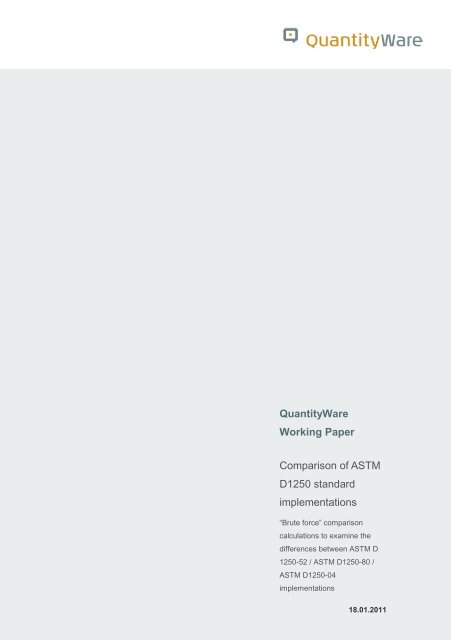
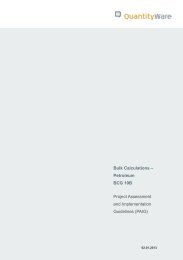
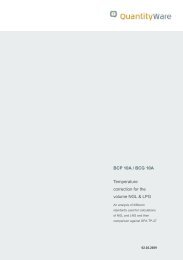

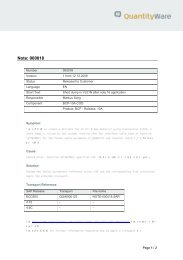
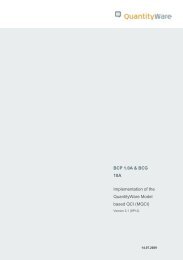
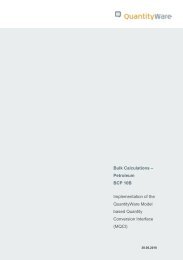
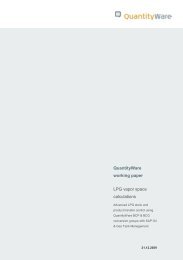
![Petroleum ASTM D1250-80 SP09 [276.9 KByte] - QuantityWare](https://img.yumpu.com/48083876/1/184x260/petroleum-astm-d1250-80-sp09-2769-kbyte-quantityware.jpg?quality=85)
![SAP QCI in a Nutshell + Notes [761.4 KByte] - QuantityWare](https://img.yumpu.com/46691308/1/178x260/sap-qci-in-a-nutshell-notes-7614-kbyte-quantityware.jpg?quality=85)
